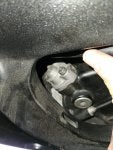That is interesting how much of a measurable change in tensioner depth you are able to measure over the miles. It does seem like excessive wear though. Must just be a different thing than the tensioner itself. Maybe your cam chain guides are made of a softer and more easily worn out plastic? 1-2mm movement on the adjuster I would think would translate to quite a bit of worn down cam chain guide plastic material. Have you looked at the plastic on the guides?
One of the awesome things I've found about my MCCT's in the bikes I've put them in is that I think to date, I have not had to adjust one unless I took it off or something. My factory spring tensioners obviously worsened as either the tensioner aged and weakened, or as some parts wore down. But since I've put the MCCT's in, those motors have show significantly less signs of wear and aging in the valvetrain, and even removing and reinstalling them, they are perfectly set still. It actually blows my mind how good they work when the engine is also in good shape. They have been more maintenance-free than the "maintenance-free" factory tensioner that is designed to last forever.
For example, my Ninja, I got it around 10,000 miles, and around 20,000 or so miles it had developed a worsening chain slapping, and with every oil change or so, it was noticeably worse. I also found that my valve clearances were getting out of spec pretty fast, and they have the 20,000mi service interval, but I was checking them more frequently than that. So around then, I put on the SpearsRacing MCCT on that bike, and I am not kidding,
my valvetrain in that bike has nearly ceased wear. The last time I checked the valves, they were all still in spec, and the cam chain has never made any noise since I installed and set the tensioner. It now has over 60,000 miles and runs fantastic. So I am led to believe that the manual cam chain tensioner is inherently better in that it doesn't
apply pressure actively to the chain while running, it just takes up the slack perfectly around the chain when set properly. And I think that has improved all running aspects of that motor. On then engines I put them on, I think subjectively the idle and low speed operation has improved from the MCCT such that it feels like the engine runs more smoothly, almost as if it isn't 'loping' over each time the camshaft lobe presses a valve in, it feels more fluid.
So to answer your first question about the chain sag, not quite. It's not like I try and set it to where there is no chain slack at all without tension, it's a tad looser than that. A very small amount looser than that. There should be an amount of sag in the chain when you press down on it in certain camshaft phases, and indeed rotating the camshaft will make it tighten and loosen as the lobes push valves open, so you want to really measure and press on the chain when some pistons are in TDC. You can watch the intake camshaft rotate slightly in reverse a few degrees as you press down on the chain for sag, and that little bit of movement indicates that the system isn't under tension, and that when it's the right amount, you have the tensioner set just right such that the chain rides on the chain guides, but
doesn't press into them nearly at all. That is why I think the stock tensioner is just inherently worse, they handle the last little bit of tension needed in the chain by pressing against it constantly with a spring, and I believe that is why they suck and wear out.
It's still a bit of a YMMV thing, but every bike I have installed an MCCT on has been blessed with improved valvetrain health, both subjectively and objectively, and more so with the precise tensioning method I described above.
Here is one video I found extremely helpful, and what he really highlights about the MCCT and its purpose is that it ideally helps you "control your cam timing" more accurately. Very helpful, I knew I could find this vid:
-Mike







